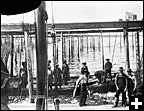Common menu bar links
Canadian statistics in 1922 and 1923
Archived Content
Information identified as archived is provided for reference, research or recordkeeping purposes. It is not subject to the Government of Canada Web Standards and has not been altered or updated since it was archived. Please contact us to request a format other than those available.
On June 19, 1915, Robert Hamilton Coats—associate editor of the Labour Gazette and Chief Statistician at the Department of Labour—was appointed Dominion Statistician and controller of the census.
The press commended George Eulas Foster, the Minister of the Department of Trade and Commerce, for his excellent choice, and Coats received a letter from William Lyon Mackenzie King, the future Prime Minister, congratulating him.
Having gained considerable experience in the Department of Labour, Coats was key in centralizing statistics and developing new statistical programs.
Centralizing statistics
Though Coats had little official training with statistics, he discovered many areas in the system that needed improvement. He wrote a bill that outlined the need to centralize official statistics in Canada, to create a central statistics office and to give that office the necessary powers to ensure departmental statistics were supplied to it. Coats’ bill was the foundation for the Statistics Act.
The Statistics Act of 1918 acted on the recommendations given by the Departmental Commission on Official Statistics conducted in 1912, of which Coats was a member. Canadian statistics, the commission reported, “as a whole, [showed] a lack of coherence and common purpose” and, among other problems, were plagued with duplication, varying degrees of quality and value, and “a lack of attention to timeliness.”
On May 24, 1918, the Statistics Act was passed in the House of Commons, thus creating the Dominion Bureau of Statistics. Its official mandate, under the Minister of Trade and Commerce, was “to collect, abstract, compile and publish statistical information relative to the commercial, industrial, social, economic and general activities and conditions of the people.”
A national system of statistics

By 1923, the national statistical system had improved considerably. Because the Census of Population could no longer sufficiently collect production statistics, the census was reorganized to accommodate a new annual industrial census to collect “statistics on the fisheries, mines, forestry, dairying, and central water and electric power.”
The 1922/1923 edition of the Canada Year Book presented the first detailed treatment of national vital statistics. While the collection of vital statistics had fallen to the provinces in the past, two national–provincial conferences were held in 1918 to discuss the benefits of a national system and by 1920 all provinces were regularly submitting vital statistics to the Dominion Bureau of Statistics—except Quebec, which started in 1926. National–provincial collaboration had also improved statistical reporting on crops and livestock so that, by 1921, the Census of Agriculture provided a basis for extended annual reports on agricultural and horticultural statistics. Also at this time many other transfers were underway to improve statistical co-ordination for statistics on foreign trade, transportation, communication, crime, public finance, education, labour and prices.
Improving the Canada Year Book

As Coats mentions in the preface to the 1922/1923 edition of the Canada Year Book, “a work of this character is dependent upon completion of the basic organization of statistics, and that it has been necessary therefore to develop the Year Book gradually, as the improved materials under the Bureau became available.” As such, the book changed as the bureau developed and grew.
One such change was the introduction of Sedley A. Cudmore, an Irish-born professor of economics at the University of Toronto, who was appointed the head of the new Education and General Statistics Branch and editor of the Canada Year Book in 1919.
Ernest H. Godfrey, the editor of the book before Cudmore, had done an excellent job reviving it after its popularity diminished under the editorship of Archibald Blue at the beginning of the century. Under Cudmore, the book became even more useful because it was “conceived from the widest point of view and present[ed] the more salient statistics of the country against a background of interpretative matter designed to bring out their significance.”
The population of Canada
In 1922, the estimated population of Canada was 9 million people. There were 162,552 births, 68,175 deaths and 47,690 marriages. The province with the highest rate of natural increase that year was Saskatchewan, at 20.2 per 1,000 people. Cancer was an increasing concern for Canadians—5,092 people died from it in 1922, compared with 4,826 in 1921.
Travel and transport in Canada

In 1922, there were 39,773 miles of steam railway tracks in operation in Canada and over 44 million railway passengers. Electric railways had been steadily growing since 1901, when the country had only 552.91 miles in operation. In 1922, there were 1,724.60 miles in operation and nearly 740 million people rode the train sometime that year.
But the train’s popularity was decreasing. According to the Canada Year Book, “there can be no doubt that motor vehicles are now serving much of the short haul traffic formally served by steam and electric railways.” By 1922, a total of 513,821 motor vehicles were registered in Canada, compared with 2,130 in 1907.
Industrial developments

The value of the products of the fisheries had been falling since 1918, when the total value for the year was $60 million. In 1921, the total value from the fisheries was only $35 million—with the most value coming from salmon, at $9 million, and lobster, at $5 million.
In 1922, 135 million lbs of factory cheese had been produced in Canada, dropping from 162 million lbs in 1921. Unfortunately, “the average price of cheese fell from 17 cents in 1921 to 16 cents in 1922.”
The Department of National Defence

In 1923, Canada’s permanent and non-permanent active militia had 126,517 men, while the Canadian Naval Reserve had 500 officers and seamen and the Royal Canadian Navy had “2 destroyers and 4 trawlers on the active list, with the light cruiser Aurora and submarines CH 14 and CH 15 in reserve.” The Royal Canadian Air Force had 49 officers and 262 men in other ranks.
On January 1, 1923, the National Defence Act consolidated the Naval Service, the Air Board and the Department of Militia and Defence into one unit—the Department of National Defence.
